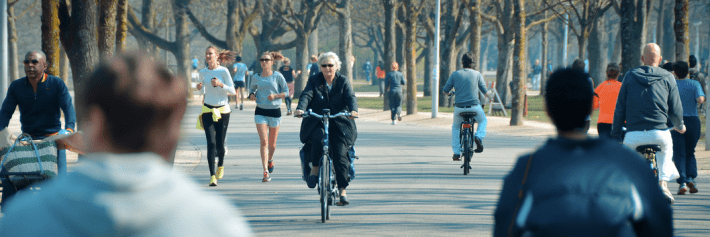Traffic Lights Don’t Belong on a Park Loop
4:11 PM EDT on September 30, 2014

Two separate crashes in which cyclists struck and killed pedestrians on the Central Park loop have garnered more media attention than any other traffic safety issue in the past two months. In addition to the inevitable reemergence of a few bikelash trolls, the collisions have led to a round of less spiteful stories that still miss the mark, framing the whole issue in terms of adherence to traffic lights. Collisions on the loop roads in both Central Park and Prospect Park are preventable, but trying to compel pedestrians and cyclists to obey signals won't get the job done.
It's easy to gather a ton of B-roll of cyclists in the parks proceeding through red lights and pedestrians crossing against the signal or outside crosswalks. This type of coverage, however, misses the point: The problem in the park isn't that people are disobeying the stop lights. The problem is the traffic lights themselves, which cause more conflict than they prevent.
Traffic signals came to New York in 1920, to impose order on what the New York Times recently called "the growing onslaught of automobiles" navigating the city's right-angled intersections. On the park loops, conditions are quite different: People crossing on foot, no longer on the lookout for high-speed motorized traffic, expect greater freedom of movement, while the stream of joggers and cyclists on the road, unencumbered by bulky metal cages and generally moving at speeds that enable eye contact with other people, can engage with their surroundings in a way that drivers cannot. It's nothing like the intersection of two city streets, yet it has similar traffic control devices.
Expecting pedestrians and cyclists in Central Park to obey traffic lights is like expecting drivers on the Belt Parkway to use hand signals before they change lanes. It's the wrong technique, applied to a situation where it just won't work.
Although stop lights were invented for automobiles, much of the time, the only cars on the park loops are police or service vehicles slowly going from one section of the park to another. During certain hours, the city opens some sections of the Central Park and Prospect Park loops to drivers looking for a shortcut. These are the only times when traffic signals make sense. When cars are not present, the signals create the false expectation that loop users will wait for permission from the light before proceeding -- and that can be dangerous.
It's unreasonable for a cyclist to assume that a green light means the path ahead will be unobstructed by pedestrians, just as it's unreasonable to expect cyclists to come to a full stop when it's safe for them to slow down and navigate around people crossing the loop, just as it's unreasonable to expect a pedestrian to wait for the light when there is clearly a safe opening to cross.
Getting rid of traffic signals in the parks is a necessary step toward creating loop roads where people on bikes and on foot rely on eye contact and common sense to safely interact, instead of rules that don't fit the context. And before that can happen, it's time to finish the job and make the parks permanently car-free, a top request among Central Park users that has support from nearby community boards. Transportation Commissioner Polly Trottenberg says she's heard the call loud and clear, but she hasn't committed to actually following through, citing the need for more study and consensus-building.
Making the loop permanently car-free and getting rid of traffic lights would clear the way for other steps. Once motorists, car lanes, and car signals no longer have to be accommodated, the range of available options to improve safety among pedestrians and cyclists expands. Training on a bike wouldn't be as appealing, but the park would become slower and safer for everyone.
City Council Parks Committee Chair Mark Levine has proposed lowering the loop's speed limit from 25 to 20 mph. That's a good rule of thumb, but especially on crowded sections of the loop south of 72nd Street, new signs won't be sufficient. Some sort of design change will be needed.
What might work? The busiest crossing points, like near Columbus Circle, are candidates for raised crosswalks. Pavement treatments could send cues to cyclists that they're approaching heavily-used areas, and markings could be overhauled to make pedestrians and cyclists more aware of each other. A constant police presence to verbally remind fast cyclists to slow down could also help.
These are just suggestions. There are a wide range of potential design fixes that the city should explore. New York City doesn't have to reinvent the wheel here -- it could invite shared space experts from countries with more experience designing car-free streets to weigh in.
Whatever the specific solutions may be, the city has to try something new -- a few weeks of ticketing cyclists for running reds won't solve the core issue: Forcing pedestrians and cyclists to obey rules made for cars is an exercise in futility.
Stay in touch
Sign up for our free newsletter
More from Streetsblog New York City
Report: Road Violence Hits Record in First Quarter of 2024
Sixty people died in the first three months of the year, 50 percent more than the first quarter of 2018, which was the safest opening three months of any Vision Zero year.
Street Sweepers Could Nab Illegal Parking Under State Bill
Smile for the street-sweeper!
Thursday’s Headlines: The Way of Water Edition
The "Blue Highways" campaign wants the mayor to convert a downtown heliport into a freight delivery hub. Plus more news.
Gotcha-Heimer! Anti-Congestion Pricing Jersey Rep. With a City Speeding Ticket Drove to Manhattan on Wednesday
New Jersey's most vociferous opponent of congestion pricing parked illegally and once got a speeding ticket.




